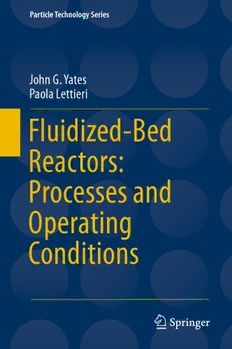
Fluidized-Bed Reactors: Processes and Operating Conditions PDF
Preview Fluidized-Bed Reactors: Processes and Operating Conditions
Particle Technology Series John G. Yates Paola Lettieri Fluidized-Bed Reactors: Processes and Operating Conditions Particle Technology Series Volume 26 Series editor José Manuel Valverde Millán, University of Sevilla, Spain Manymaterialsexistintheformofadispersesystem,forexamplepowders,pastes, slurries,emulsionsandaerosols,with sizerangingfromgranularallthewaydown to the nanoscale. The study of such systems necessarily underlies many technolo- gies/products and it can be regarded as a separate subject concerned with the manufacture, characterization and manipulation of such systems. The series does not aspire to define and confine the subject without duplication, but rather to provide a good home for any book which has a contribution to make tothe record of both the theory and applications of the subject. We hope that engineers and scientists who concern themselves with disperse systems will use these books and that those who become expert will contribute further to the series. TheSpringerParticleTechnologySeriesisacontinuationoftheKluwerParticle Technology Series, and the successor to the Chapman & Hall Powder Technology Series. More information about this series at http://www.springer.com/series/6433 John G. Yates Paola Lettieri (cid:129) Fluidized-Bed Reactors: Processes and Operating Conditions 123 JohnG.Yates PaolaLettieri Department ofChemical Engineering Department ofChemical Engineering University CollegeLondon University CollegeLondon London London UK UK ISSN 1567-827X Particle Technology Series ISBN978-3-319-39591-3 ISBN978-3-319-39593-7 (eBook) DOI 10.1007/978-3-319-39593-7 LibraryofCongressControlNumber:2016944913 ©SpringerInternationalPublishingSwitzerland2016 Thisworkissubjecttocopyright.AllrightsarereservedbythePublisher,whetherthewholeorpart of the material is concerned, specifically the rights of translation, reprinting, reuse of illustrations, recitation, broadcasting, reproduction on microfilms or in any other physical way, and transmission or information storage and retrieval, electronic adaptation, computer software, or by similar or dissimilarmethodologynowknownorhereafterdeveloped. The use of general descriptive names, registered names, trademarks, service marks, etc. in this publication does not imply, even in the absence of a specific statement, that such names are exempt fromtherelevantprotectivelawsandregulationsandthereforefreeforgeneraluse. The publisher, the authors and the editors are safe to assume that the advice and information in this book are believed to be true and accurate at the date of publication. Neither the publisher nor the authors or the editors give a warranty, express or implied, with respect to the material contained hereinorforanyerrorsoromissionsthatmayhavebeenmade. Printedonacid-freepaper ThisSpringerimprintispublishedbySpringerNature TheregisteredcompanyisSpringerInternationalPublishingAGSwitzerland This book is dedicated to the next generation; Alice, Robin, Polly, Georgia, Phoebe and Jasper Foreword Fluidized beds are ubiquitous in a variety of chemical and physical processing applications as well as in natural phenomena. Despite many decades of intense research efforts on fundamentals and applications, fluidized beds still disclose unrevealed features and pose challenging issues to the researcher, the process engineer, the natural scientist. Fluidized-Bed Reactors: Processes and Operating Conditions offers the reader an up-to-date survey of successful applications of the fluidized bed technology to chemical and process industry. The book is unique in that it provides a historical perspectiveonthedevelopmentoffluidizedbedsindustrialapplications,addressing both the success stories and the operational problems encountered in developing fluidized bed processes. This “evolutionary” approach is helpful in developing a rationale for the use of fluidized beds and in discussing the proper selection of processconditionsforsuccessfuldesignandscale-upandfortrouble-freeoperation offluidized bed process units. Of particular interest is the consideration of the influence of temperature and pressure on fluidization in many industrial processes operated at far-from-ambient conditions. Moreover the importance of the often-disregarded role of interparticle forces is scrutinized and surveyed. This analysis benefits from the well-recognized competence of the authors on fluidization under “extreme” process conditions and on fluidization offine particles. Thebookisanexcellentandinstructivereadingforundergraduateandgraduate students in chemical engineering and industrial chemistry and provides useful information to professional process engineers and chemists. Piero Salatino vii Preface Fluidization, a technique in which an assembly of solid particles is held in suspensionbyanupward-flowingfluid,hasbeenpractisedintheprocessindustries forover80years.AnearlyapplicationwastheWinklerprocessforthegasification of coal closely followed by the fluidized catalytic cracking process for the pro- ductionofgasoline.Sincethemiddledecadesofthetwentiethcenturythetechnique has spread widely from fine chemicals to the heavy industries such as uranium processingandsulfide-oreroastingsothattodayitrepresentsalongwithdistillation, crystallization, filtration, etc. one of the major unit operations in the chemical engineer’stoolbox.Runninginparallelwiththeseindustrialdevelopmentshasbeen atrulyenormousresearchanddevelopment activity inboth industryandacademia aimed at achieving a better understanding of the hydrodynamics offluidized beds and at how this may be applied to the improvement of existing processes and the development of new ones. Thefocusinthepresentvolumeisonthedesignandoperationofthecentrepiece ofaprocess,thereactoritself,emphasizingthereasonsforchoosingfluidizedbeds ratherthanalternativessuchasfixedbedsinthecontextofaparticularprocess.The book begins with a brief history of fluidization covering decade by decade the period from the 1940s to the first decade of the twenty-first century describing the processes introduced and highlighting their successes and failures. Basic research into the subject is outlined and attention drawn to the theoretical and experimental advancements achieved during this period. The second chapter con- siders industrial processes based on heterogeneous catalysis such as olefin poly- merization and catalytic cracking while the succeeding chapter looks at the non-catalytic routes to materials such as ultra-pure silicon and titanium dioxide; fluidized-bedcombustionandgasificationofconventionalfuelsarealsoconsidered aswellastherelatively newtechnique ofchemicalloopingcombustion.Chapter4 is concerned with conversion processes for biomass and waste materials while Chap.5looksattheeffectsoftemperature,pressureandparticle-sizedistributionon designandoperatingconditions.Thebookconcludeswithachapteronthescaling and scale-up of reactors. ix x Preface The treatment throughout is at the postgraduate/postexperience level but practising engineers and scientists concerned with gas–solid systems will, it is hoped, find much of interest. London, UK John G. Yates 2016 Paola Lettieri Acknowledgements The authors wishtoacknowledge those who havebeen sohelpful inpreparingthe material for this book. We are very grateful to the Fluidization Group inChemical Engineering at University College London, in particular to Dr. Massimiliano Materazzi for his contribution in writing Chap. 4, Mr. Domenico Macri’ for his assistancewithsortingoutthecopyrightforallthefiguresincludedinthebookand toMissCarlaTagliaferriforassistingintheliteraturesearch.Wearealsogratefulto Prof. Gregory Patience of the Ecole Polytechnique Montreal for helpful corre- spondence relating to the DuPont CFB process for maleic anhydride. Wehave dedicatedChap. 5toourdear friend andcolleague,thelate Dr. David Newton,forhiscontributiontotheresearchdescribedinthechapter.Davidwasan expert and a practitioner in the field of fluidization. He had joined John Yates’ researchgroupatUCLin1981toworkontheeffectoffineparticlesonthecatalytic dehydrogenation of butene to butadiene, a model reaction used to probe the basic fluiddynamicsofthesereactors.DavidwentfromUCLdirectlytotheBPResearch CentreatSunbury-on-Thames,UKwherehecontinuedhisworkinfluidizationand became Head of the Fluidization Group at BP Chemicals. Paola joined David’s Group at BP in 1995 and together with John continued to work with David on the many challenges described in Chap. 5 until December 2009, when David sadly passed away after being diagnosed with asbestosis. Finally a word of sincere thanks to the staff at Springer, particularly Mieke van der Fluit, for their constant encouragement and guidance. xi
